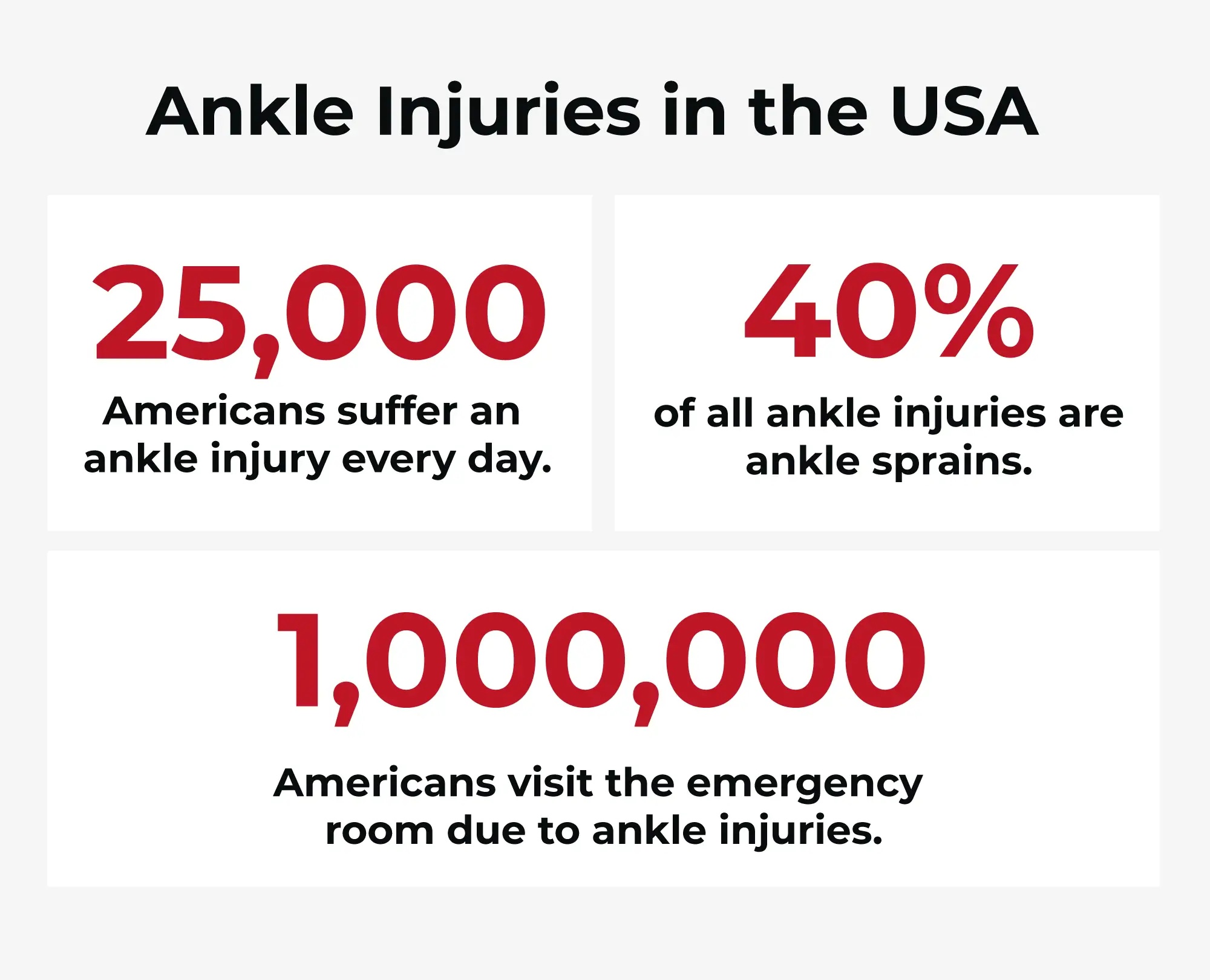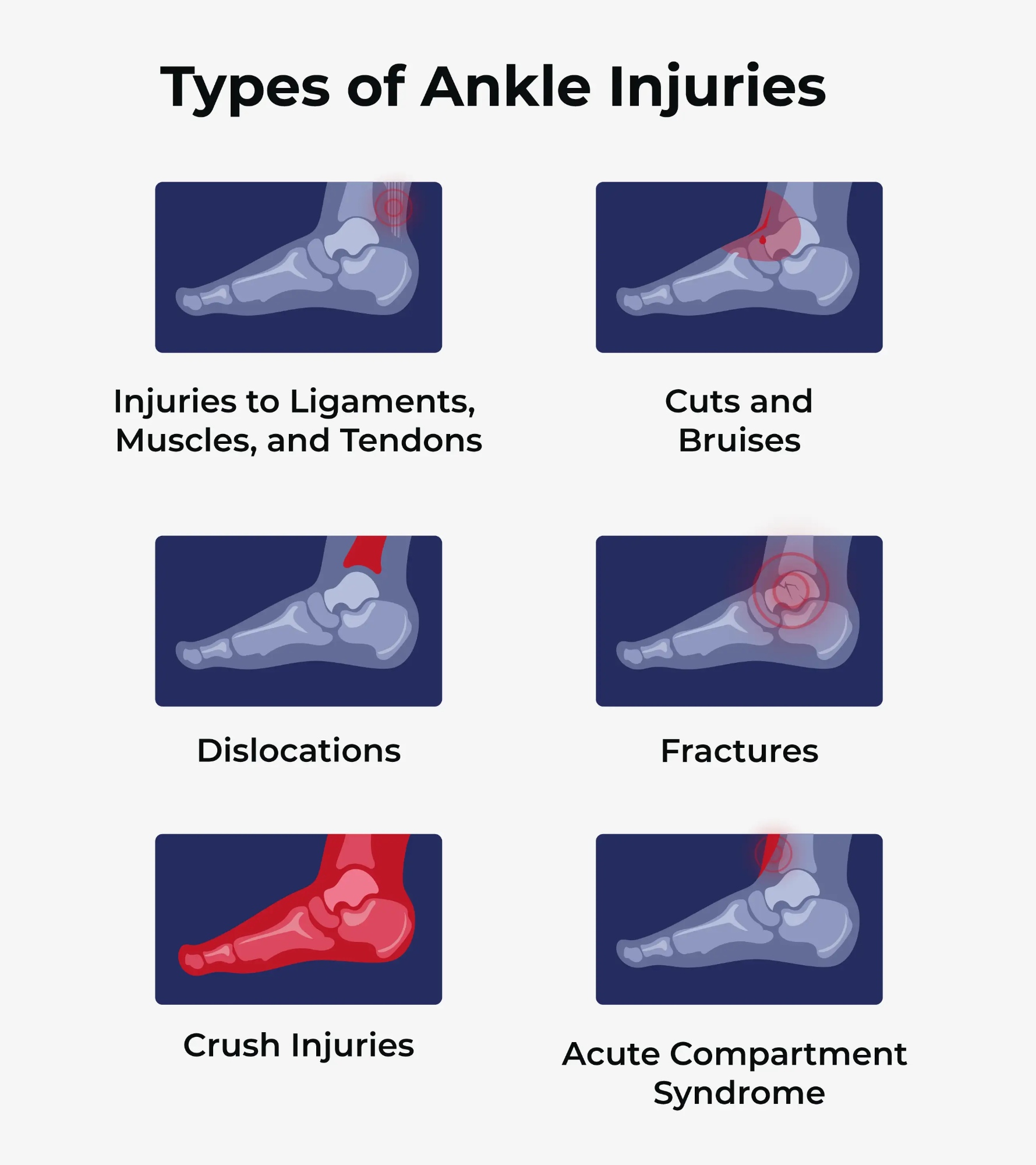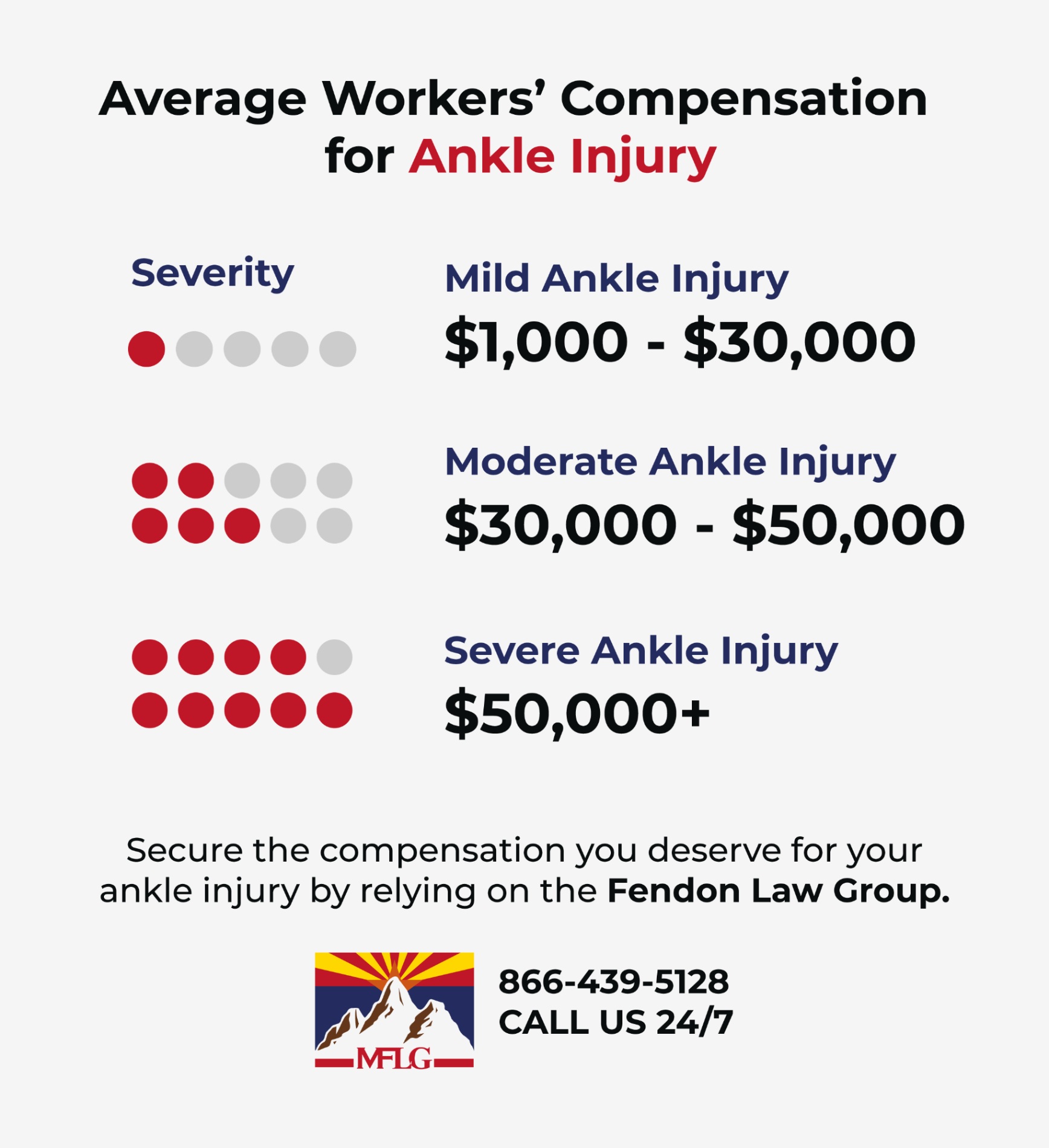Workers’ Comp Ankle Injury Settlement
Suffering an ankle injury can affect your ability to make a living, and medical treatment can be costly. Fortunately, work-related ankle injuries are compensable with Arizona workers’ compensation benefits.
Here, we will cover the kinds of ankle injuries you can experience on the job, their causes, treatment, and how workers’ compensation benefits can help to cover your medical bills and part of your lost wages while you cannot return to work.
We will also show you how having a high-quality workers’ compensation attorney, like one of the workers’ compensation lawyers at the Matt Fendon Law Group, can help you to prepare your initial workers’ compensation claim or to appeal if your employer’s workers’ compensation insurance company denies your claim.
If you have suffered ankle injuries, call us today at (800) 229-3880 to schedule a confidential, free consultation with an experienced workers’ compensation lawyer in Phoenix
How Common Are Ankle Injuries?
Every day, about 25,000 Americans suffer an ankle injury. Some of these ankle injuries are serious enough to send about a million Americans to emergency rooms every year. And every year, workers’ compensation insurance companies in Arizona and throughout the United States spend billions of dollars to cover the direct and indirect costs of ankle injury treatment.
Of the three general kinds of ankle sprains—lateral, medial, and high—the most common kind of ankle sprain is the lateral ankle sprain. A lateral ankle sprain is the diagnosis for more than 90 percent of ankle sprains. It occurs when the foot is forcefully rolled inward, toward the midline of the body, causing damage to the ligaments on the outside of the ankle as they stretch and/or tear rapidly. Women are somewhat more likely to experience an ankle sprain than men are; of all ankle injury sufferers, 57 percent are women.

Causes of Ankle Injury
The most common cause of ankle injury is engaging in sports activities. For our Arizona workers’ compensation purposes, though, we will focus on the ways you can injure your ankle on the job.
Common Causes of Work-Related Ankle Injuries in Arizona
Any activity at work that can subject your ankle to unnatural movements or trauma can lead to an ankle injury. On-the-job sources of ankle injuries we often see are falls caused by slipping or tripping, rolling the ankle on an uneven surface, twisted ankles, knee impacts from causes like car accidents and accidents involving equipment.
Types of Ankle Injuries
Your ankle is made up of different kinds of tissue, including bones, tendons, ligaments, and muscles. The kind of ankle injury you suffer depends on which part of your ankle joint is injured, and how.
Here are some common kinds of job-related ankle injuries Arizona employees experience.

Injuries to Ligaments, Muscles, and Tendons
Three ways you can experience an injury to the ligaments, muscles, and tendons in your ankle are sprains, strains, and a ruptured Achilles tendon.
Strains and Sprains
Whether you suffer an ankle sprain or an ankle strain depends on which part of your ankle anatomy is hurt:
- If you stretch or tear a ligament in your ankle, that is a sprain injury.
- If you stretch or tear a tendon or muscle in your ankle, that is a strain.
Doctors measure sprains on a grade scale of increasing severity, including Grade 1 (some stretching of the ligament), Grade 2 (some tearing of the ligament), and Grade 3 (complete tearing of the ligament). A Grade 1 or Grade 2 sprained ankle can force you to miss work for days or weeks. A Grade 3 sprain can result in months of missed work and may culminate in a permanent disability.
Strains, which entail damage to muscle tissue, happen more often than sprains, which pertain to ligamentous tissue damage. Mild strains and sprains can result in minor pain and some swelling, and may take a few days to heal. A severe strain or sprain can require weeks or even months to recover from.
Tendon Injuries
Although an Achilles tendon rupture is an injury that occurs most often in sports, it can happen in the workplace if you experience a fall or other forceful blow to the tendon, like a car accident or crushing injury. A ruptured Achilles tendon is a serious injury that can take months or even years to heal, and even after healing, will be more likely to suffer re-injury. Workers who suffer from Achilles tendon injuries often are unable to return to their former occupations.
Another tendon in the ankle that you can injure at work is the posterior tibial tendon. You can tear this tendon through a slip and fall accident, or through receiving a blow to the ankle, leading to a condition called posterior tibial tendon dysfunction. Left untreated, this condition can lead to the loss of the arch of your foot and to instability while walking.
Posterior tibial tendon dysfunction usually requires wearing a cast or boot for a few months, but if the condition persists longer than six months, surgery may be needed.
Cuts and Bruises
Cuts to your ankles can happen as the result of motor vehicle accidents, when skin can be exposed to broken glass or another sharp surface. Although severe cuts may require sutures as part of the healing process, most of the time these laceration injuries will not require significant treatment.
Bruises, also known as contusions, result from trauma to the ankle. These are almost always minor injuries that can cause discomfort but seldom require treatment more than an over-the-counter pain medication and a cold compress.
Dislocations
Dislocations affect bones in the ankle. A dislocation occurs when one or more ankle bones is forced out of its normal position. Sometimes a dislocated ankle bone can be repositioned without the need for surgery, but in more severe cases surgery is needed.
Fractures
A fractured ankle happens when one of your ankle bones, like the fibula, tibia, or talus, suffers a breakage. Ankle fracture injuries can be relatively minor, like a closed hairline fracture that requires wearing a cast, or more serious like a pilon fracture of the tibia that could need surgery to repair. In some cases, multiple broken bones can also cause a syndesmotic injury, in which damage to surrounding ligaments and tendons occurs.
Crush Injuries
As the term suggests, a crush injury happens when your ankle is subjected to compressive forces that can cause bone and soft tissue injuries. Sprains, strains, bruising, ankle fractures, and dislocations can all be part of an overall crush injury to your foot or ankle.
Acute Compartment Syndrome
A compartment describes a group of muscles, blood vessels, and nerves held together by a membrane. Acute compartment syndrome describes a buildup of pressure within this grouping, caused by bleeding and swelling within the membrane, which can occur after a crushing injury, broken bone, or severe trauma to the ankle like an auto accident injury.
Acute compartment syndrome is a severe injury that if left untreated can lead to muscle paralysis and, in extreme cases, death.
Treatment for Work-Related Ankle Injuries in Arizona
The treatment you receive for an on-the-job ankle injury will depend on the injury diagnosis your doctor provides you. Treatment options can be nonsurgical or surgical.
Non Surgical Ankle Injury Treatments
Some of the non-invasive treatments available for ankle injuries include braces or other orthotic devices, prescribed pain and anti-inflammatory medications, steroid injections, and physical therapy.
Surgical Ankle Injury Treatments
Because the ankle is a complex joint mechanism, several surgical options exist to treat more serious kinds of ankle injuries. These include:
- Ankle arthroscopy. This procedure removes bone and cartilage fragments, and is also used in treatment of severe ankle sprains.
- Ankle fusion (ankle arthrodesis). This surgery fuses certain ankle bones together. It is often used to treat arthritis symptoms.
- Ankle reconstruction. This procedure grafts together tissue from some tendons or ligaments to repair a torn ligament.
- Gastrocnemius recession. The purpose of this procedure is to lengthen your Achilles tendon. It is used to treat problems with moving your ankle in an upward direction, or to treat a flatfoot condition.
- Open reduction internal fixation. This surgery repositions ankle bones for proper alignment. Used to treat ankle fractures, this procedure can involve placement of rods, screws, or plates into some of the bones of the ankle.
- Osteotomy (calcaneal osteotomy). A treatment used to treat an acquired flatfoot condition, this procedure involves breaking up the heel bone and repositioning other bones in the ankle.
- Tenosynovectomy. This treatment is for mild tendon injuries that are not related to a flatfoot condition.
- Tendon transfer. This procedure replaces one tendon with another from a different part of your foot.
- Total ankle arthroplasty. Also known as total ankle replacement, this procedure is used for treatment of ankle arthritis.
How an Ankle Injury Affects Employment and Compensation
You need your ankles to perform many of the movements and functions that employees must be able to perform as part of their jobs. These include walking, standing, climbing stairs, ramps, or ladders, balancing, lifting, and driving.
Arizona Workers’ Compensation for Ankle Injuries
If your employer is covered under the Arizona system of workers’ compensation insurance, then in most cases of injuring your ankle at work, workers’ compensation benefits will be your solution.
An important advantage to you in using Arizona workers’ compensation compared to suing your employer in a personal injury case is that you do not have to prove that your employer was at fault for the accident or workplace environment that caused your ankle injury. All you need to establish is that the injury occurred in connection with your work. You do this through your doctor or other treating healthcare provider, who will document the ankle injury diagnosis in your medical records and develop a treatment plan for the injury.
For your employer, the advantage of participating in Arizona workers’ compensation is that it can avoid having to defend itself against employee personal injury claim lawsuits. Workers’ compensation benefits also do not include awards for non-economic damages like employee pain and suffering.

Types of Workers’ Compensation Benefits Available for Different Ankle Injuries
Depending on the seriousness of your ankle injury, how it limits your ability to work, and the kind of treatment you need, under Arizona workers’ compensation you may be able to claim from among the following benefits:
- Temporary partial disability. In this situation, your ankle injury might not prevent you from working, but it may require you to be temporarily assigned to fewer work hours or to light duty.
- Temporary total disability. This occurs when your ankle injury prevents you from working, but only for a relatively short time.
- Permanent partial disability. This describes a status in which your injury does not prevent you from returning to work, but does preclude you from being able to work full-time. This kind of benefit is based on medical considerations and not on lost wages, so you can receive permanent partial disability even if you can still work.
- Permanent total disability. If your ankle injury is severe, it could prevent you from going back to work in your past occupation or any other you might otherwise qualify for.
- Vocational rehabilitation. If you cannot return to your old job, Arizona workers’ compensation provides for job retraining and education.
- Transportation and mileage reimbursement. If you must travel to receive treatment for your ankle injury, then workers’ compensation can reimburse you for transportation and mileage costs to and from treatment appointments.
- Lost wages compensation. Arizona workers’ compensation can pay you up to two-thirds of your pre-injury salary or wage.
Lump Sum Settlement for Ankle Injury in Arizona
Like most work-related injuries, foot and ankle injuries can harm you directly and indirectly, and in short-term and long-term ways. If you choose to settle with your employer’s workers’ compensation insurance company, then Arizona workers’ compensation law allows you and the insurance company to negotiate a lump sum settlement agreement.
Should You Have an Arizona Workers’ Compensation Attorney?
In an ankle injury case, you can represent yourself in settlement negotiations with the workers’ compensation insurer. The Arizona system of workers’ compensation can be complex, however, and is subject to regulations and timelines that can become traps for unwary workers’ compensation claimants.
Know as well that whether or not you hire an Arizona workers’ compensation lawyer, like one of our expert workers’ comp attorneys at the Fendon Law Group, the workers’ comp insurance company will have a workers’ compensation lawyer working for it. And that lawyer is under no ethical obligation to help you get what you need, not to mention everything you deserve.
Factors to Consider in Arizona Workers’ Comp Ankle Injury Settlements
Although a minor ankle injury, like a Grade 1 sprain, may cost only a few hundred dollars (and less than a week away from work) to treat, more serious foot and ankle injuries can lead to six-figure workers’ compensation insurance ankle injury settlement amounts. Here we look at some of the considerations that go into negotiating ankle injury settlement compensation that is right for you.
The Seriousness of the Injury
The more serious the ankle injury, the more it will cost to treat and this will need to be factored into your workers’ compensation settlement agreement.
Symptoms and conditions that indicate more serious underlying ankle injuries can include:
- The level or grade of any impairment rating you may receive
- Displaced bones or complex fractures that require surgery to treat
- Nerve damage
- Amputation
- The need for an ankle replacement
- Permanent injury to a ligament or tendon
- Crush injuries or acute compartment syndrome
- Inability for the affected ankle to bear weight
- Permanent instability or walking with a limp
- Onset of arthritis
- Chondral injuries (injury to cartilage)
- Arthrofibrosis (pain, stiffness, and limited motion because of scar tissue formation)
- Synovitis (prolonged ankle swelling)
- Onset of complex regional pain syndrome, a debilitating and incurable condition also known as reflex sympathetic dystrophy.
Medical Treatment Costs
The average settlement costs to diagnose and treat an ankle injury can add up quickly. X-rays can cost hundreds or thousands of dollars. A cast can be $2,000 or more. Treating a broken ankle injury will frequently require medical treatment that will cost in the five-figure range for physician fees and surgery if necessary.
Some specific ankle injury medical treatment cost items to keep in mind when determining your settlement value include:
- Hospital bills
- Physician bills
- Surgery bills
- Ambulance bills
- Radiology bills (X-rays, MRIs, CT scans)
- Bills for required medical equipment
- Physical and vocational rehabilitation costs
- Prescription medication costs
- Long-term, ongoing medical treatment costs for future medical expenses
Your Personal Characteristics
Factors the insurance company will consider when negotiating with you can include how old you are, your weight, what your life expectancy is, your prior medical history, and what your occupation is.
Non-Medical Costs
Aside from direct costs of treating your ankle injury, like your medical expenses, you can suffer other economic losses during your treatment. The most significant of these costs are the income and employment-related benefits you can lose while you cannot work. You will need to support lost income and benefits claims with documentary evidence from your employer.
Other non-medical costs that Arizona ankle injury workers’ compensation settlements can factor in include your travel costs to and from treatment appointments, or costs if you need to hire someone to help you to keep up with household activities if you are immobilized.
Talk to an Arizona Workers’ Compensation Lawyer Today
At the Matt Fendon Law Group, our highly skilled and compassionate workers’ compensation lawyers are ready to help you with all aspects of your ankle injury claim. We have helped Arizona workers with ankle injury cases in Phoenix and other locations in Maricopa County and Arizona.
We can help you:
- Understand what is happening. The process of obtaining ankle injury workers’ compensation benefits can be stressful and complicated. It’s critical that you have an experienced Arizona workers’ comp lawyer on your side.
- Deal with your employer. Employers often try to intimidate or take advantage of injured workers. The attorneys at Matt Fendon Law Group will stand up for your rights.
- Negotiate with the insurance carrier. Insurance carriers are less likely to give you the run-around when you have a skilled and aggressive attorney in your corner.
- Receive the compensation you deserve. While you recover from your ankle injury, workers’ compensation benefits pay a portion of your lost wages, as well as your medical bills. Our attorneys will fight to get you the benefits you need and deserve.
- Represent you at the hearing. A hearing before an administrative law judge could be required. When that is the case, our attorneys will represent you and argue your ankle injury claims on your behalf.
- Handle your appeal. If your workers’ compensation claim is denied, our experienced workers’ compensation lawyers can help you to put together the strongest argument on your behalf within the tight 90-day appeal deadline.
- File a civil lawsuit. If your employer fails to maintain workers’ compensation, litigation may be necessary. A Fendon Legal Group personal injury lawyer can file an ankle injury lawsuit on your behalf.
If you have suffered ankle injuries, call us today at (800) 229-3880 to schedule a confidential, free consultation with an experienced workers’ compensation lawyer in Phoenix. Or, if you prefer, you can contact us online to ask a question or to schedule a free consultation.
We have an office in Phoenix and other surrounding areas. Let us show you how we can help you with your Arizona workers’ comp ankle injury claim. We will provide straightforward advice and help you understand your legal options.



















